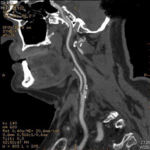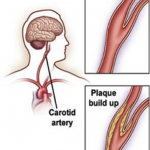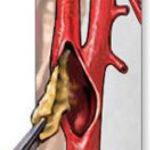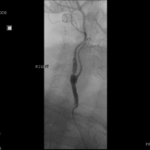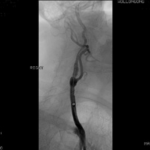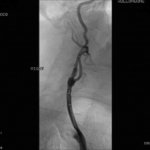Carotid Endarterectomy & Carotid Stenting
What is carotid endarterectomy?
Carotid endarterectomy is an operation during which your vascular surgeon removes the plaque of your carotid artery that has cause the artery to become narrow. This procedure restores blood flow and it also prevents pieces coming loose and travelling to the brain
What happens during a carotid endarterectomy?
You may either be put to sleep or, alternatively, your anaesthesiologist or surgeon can numb your neck area and keep you awake. Once you are either asleep or the area around your neck is completely numb, your surgeon will shave the skin on your neck where he or she is going to make an incision, to help prevent infections. Your surgeon then makes the incision on one side of your neck to expose your blocked carotid artery. The carotid artery is then clamped to stop blood from flowing through it. During the procedure, your brain receives blood from the carotid artery on the other side of your neck. Alternatively, a shunt can be used to detour the blood around the artery that is being repaired.
After the carotid artery is clamped, the blocked section is opened. Next, your surgeon peels out the plaque deposit by removing the inner lining of the diseased section of your artery. After removing the plaque, your surgeon stitches your artery, removes the clamps or the bypass, and stops any bleeding. He or she then closes your neck incision and the procedure is complete. Often, a patch is used to widen the artery as part of the procedure. The patch material used can be one of your own veins, or a variety of synthetic materials depending upon your particular circumstance. The procedure takes about 2 hours to perform but may seem slightly longer depending upon the anaesthetic and preparation time.
What can I expect after a carotid endarterectomy?
After surgery, you may stay in the hospital for 1 to 3 days. During this time, your physician will monitor your progress. Initially, during your recovery, you will receive fluid and nutrients through a small, thin tube called an intravenous (IV) catheter. Because the neck incision is so small, you may not feel significant pain.
After you go home, your physician may recommend that you avoid driving and limit physical activities for several weeks. You can usually begin normal activities again several weeks after the operation.
If you notice any change in brain function, severe headaches, or swelling in your neck, you should contact your physician immediately.
What are the risks of the operation?
The risks will depend on several factors, like your overall health, past history of heart problems, strokes or blockages on the other side. Like with any operation complications may occur. A stroke or heart attack are possible complications following a carotid endarterectomy. This risk is low, ranging between 1 and 3 percent. Another unusual complication is the re-blockage of the carotid artery, called re-stenosis, which may occur later, especially if you continue to smoke cigarettes. The chance of developing a restenosis severe enough to require another carotid endarterectomy is usually about 2 to 3 percent. Nerve injury, leading to hoarseness, difficulty with swallowing, or numbness in your face or tongue, are also possible complications. This usually clears up but it might take several months. All this risks will be discussed with your doctor and weighed against your personal risk of having a stroke if the carotid disease is not treated.
Finally…
This website should have answered some of your questions, but remember that this is only a starting point for discussion about your treatment with the doctors looking after you.
What is carotid angioplasty and stenting?
Another technique is carotid artery stenting where your vascular surgeon inserts a slender, metal-mesh tube, called a stent, which expands inside your carotid artery to increase blood flow in areas blocked by plaque.
The procedure usually takes place in an angiography suite or hybrid theatre. Before the procedure begins, your physician will connect you to a monitor that shows your heart rate and blood pressure. During the procedure, your physician will likely talk to you and may instruct you to squeeze a small toy or ball so that he or she can monitor your brain function.
The procedure is done through a needle in the groin (under local anaesthetic) and a catheter is passed up to the carotid artery in the neck. Your physician then locates the narrow areas in your artery by injecting dye and taking x-rays. At this point in the procedure, your physician may insert a small balloon, basket, or filter called an embolic protection device. This device helps to prevent strokes by catching the clots or debris that may break away from the plaque during the procedure.
Before inserting the stent, your physician will usually perform angioplasty This is where a balloon on a catheter is positioned in the narrowing and then inflated. This opens the narrowing enough to allow a stent to be placed in the narrowing. The stent is then opened even further with a larger balloon. You will not feel the catheters as they move through your arteries because there are no nerve endings inside your arteries.
Are there any risks?
Major complications are possible but rare. Blockage by a clot or other debris in an artery in your brain, called an embolism, is the most serious complication. This blockage can cause a stroke. Other complications that may cause a stroke include a blood clot forming along the stent or a tear in the artery wall called a dissection. The re-blockage of the carotid artery, called restenosis, is another possible complication. The dye used for the angiogram can sometimes cause damage to the kidneys, especially in people who already have kidney trouble. Bleeding from the puncture site in the groin or arm artery, called a hematoma or a false aneurysm, can also occur, but this is unusual. Bruising and mild tenderness at the puncture site is common and resolves with time.
Finally…
This website should have answered some of your questions, but remember that this is only a starting point for discussion about your treatment with the doctors looking after you.
